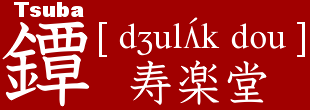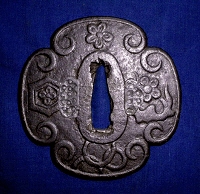Kamakura-Tsuba

-

- [ Kamakura-Bori ]
Wood engraving folkcraft
The nominal designation of Kamakura-Tsuba comes from the fact that its carving style is similar to Japanese wood engraving folkcraft "Kamakura-Bori".
So, it has nothing to do with the name place "Kamakura" in Sagami Province (present Kanagawa Prefecture) and also nothing to do with the Kamakura period (1192 - 1333) of Japan.
The features of Kamakura-Tsuba are that
(1) Only iron plate is used as material.
(2) Flowers and grass such as Kiku (=chrysanthemum) or arabesque,
or castles in Chinese styles are expressed in Kamakura-Bori relief
carving method.
We can say that the Kamakura-Tsuba is descended from the Tosho-tsuba or the Katchushi-Tsuba.
Though, most of Kamakura-Tsuba were mass-produced during the period of Civil War for fair demand of sword guards.
So, basically, forging of iron plate of Kakakura-Tsuba is not done well
compared to Tosho-Tsuba and Katchushi-Tusba.
As a result, it's a pity that there is little luster on their surfaces even
though we care for them.
All and singular Kamakura-Tsuba have no inscription on their surfaces.
-

- [ Kamakura-tsuba ]
The Momoyama period (estimate)
-

- [ Kamakura-tsuba ]
The Momoyama period (estimate)



